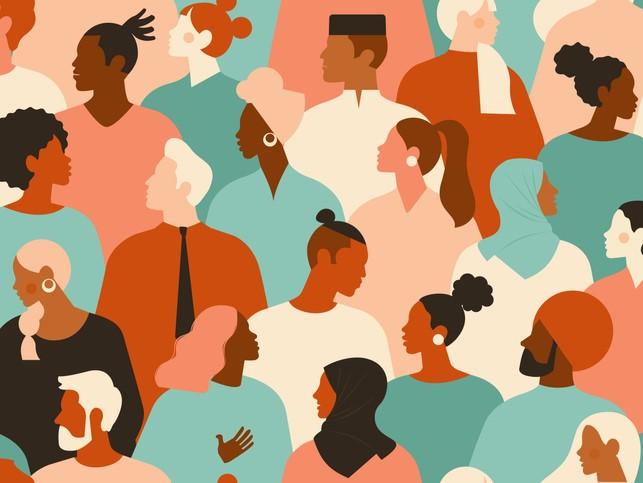“The difference between the right word and the almost-right word is the difference between a lightning bug and the lightning,” wrote Mark Twain. This sentiment rings true in a multicultural higher education landscape, where the language used to discuss equality, diversity and inclusion (EDI) holds immense power. It shapes perceptions, influences behaviours and can either bridge or widen the gaps between communities. However, navigating this language is fraught with challenges.
Terms meant to be inclusive can sometimes be misunderstood or misused in different cultural contexts, leading to unintended offence or exclusion. A few examples include “people of colour” – popular in the US, this can seem too generic in the UK, while BAME (Black, Asian and ethnic minority) is criticised by the Commission on Race and Ethnic Disparities for lumping diverse groups together, thus ignoring unique challenges. “Disabled person” aligns with the social model of disability, focusing on societal barriers, whereas “person with disabilities” emphasises individuality but can seem distancing. Similarly, “minority” implies numerical inferiority, potentially devaluing groups, whereas “marginalised group” better captures systemic issues but may be less understood. “Diverse” celebrates variety but can obscure specific identities, which are better highlighted by naming specific groups.
This article explores why mastering the language of diversity is crucial in higher education and offers practical strategies to improve communication and foster genuine inclusivity.
The importance of inclusive language
Inclusive language acknowledges and respects the diversity of people in higher education institutions. It’s essential for creating environments where everyone feels valued and understood. Missteps in language can perpetuate stereotypes, reinforce biases and alienate marginalised groups. Conversely, thoughtful and precise language can promote understanding, reduce misunderstandings and build stronger, more cohesive academic communities. For educators, administrators and staff in higher education, understanding and using the correct EDI terminology is a vital skill.
Practical solutions for navigating EDI language
1. Education and continuous learning
Understanding the language of diversity begins with education. EDI terminology is continually evolving and staying informed is crucial.
EDI training programmes: Enrol in comprehensive EDI training programmes and attend workshops and seminars focused on inclusive language. These can provide hands-on practice and real-world examples. The Advance HE network frequently hosts events and provides resources on EDI practices in higher education.
Reading resources: Regularly read books, articles and other resources on EDI topics. Recommended readings include Why I’m No Longer Talking to White People About Race by Reni Eddo-Lodge and Natives: Race and Class in the Ruins of Empire by Akala.
2. Implementing practical tools
Various tools and resources can assist in using inclusive language effectively.
Inclusive language guides: use guides provided by organisations such as Oxfam’s inclusive language guide or Collaborative Capacities’ inclusive practice glossary for facilitators. These resources offer detailed advice on the appropriate use of inclusive terminology.
Feedback mechanisms: create channels for feedback where colleagues and peers can gently correct language missteps. This fosters a learning environment and helps everyone improve their EDI language skills. For example, implementing anonymous feedback forms can allow individuals to provide honest feedback on language use without fear of reprisal.
3. Tailoring communication styles
Active listening: practise active listening to understand how individuals identify and the terms they prefer. This shows respect and fosters trust.
Clear and direct communication: avoid jargon and overly complex terms. Clear and direct language helps to ensure everyone understands the message and feels included. For example, instead of using terms like “underrepresented minorities”, specify the groups you are referring to, such as “Black and minority ethnic students”.
- Resource collection: Being Black in the academy
- We need systemic change to tackle EDI in education
- The language of inclusivity is not inclusive
4. Applying EDI language across contexts
The application of inclusive language can vary widely depending on the setting within UK higher education.
Cultural sensitivity: recognise that different cultural and institutional contexts may require different approaches to language. What is considered inclusive in one context may not be in another. For example, terminology used in urban universities with a diverse international student body might differ from that in rural colleges with a more homogeneous population.
Educational institutions: in universities and colleges, educators should use inclusive language in curricula, classroom discussions and official communications. Inclusive syllabi and teaching materials that reflect diverse perspectives are crucial. For instance, incorporating texts by authors from diverse backgrounds in literature courses can help reflect the diversity of student experiences.
Workplaces: in academic and administrative offices, inclusive language should be standard in all communications, from job postings to internal memos. HR departments can play a key role by providing training and resources. For example, using gender-neutral language in job descriptions and ensuring they are free from biased language can attract a more diverse pool of candidates.
Public engagements: for university leaders and public officials, using inclusive language in speeches, public statements and community outreach can help build more inclusive and supportive academic communities. For instance, acknowledging the land and history of Indigenous peoples during public events shows respect and inclusivity.
Improving outcomes through inclusive language
The use of inclusive language has tangible benefits as supported by research. Here are a few:
Enhanced understanding and collaboration: when everyone feels understood and respected, collaboration improves. This is particularly important in diverse academic teams where varied perspectives can drive innovation.
Reduced bias and discrimination: consistent use of inclusive language helps dismantle stereotypes and reduce unconscious biases, leading to a more equitable environment.
Increased engagement and morale: students and staff who feel respected and valued are more likely to be engaged and motivated, whether in academic settings, research or administrative roles.
Navigating the language of diversity is a continuous journey that requires commitment and effort. Embracing this evolution not only improves individual interactions but also strengthens our academic communities as a whole. As we move forward, let’s continue to learn, adapt and use our words to build bridges, not barriers.
Yusra Siddiqui is a lecturer and academic lead for student support (race, equality and inclusion) at the department of biosciences,at the University of Exeter.
If you would like advice and insight from academics and university staff delivered direct to your inbox each week, sign up for the Campus newsletter.




comment1
(No subject)